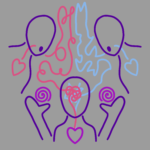Margaux Trexler
My Second Training Session with Mediator Elizabeth Franz of Humanz Mediate
In my second training session with Mediator Elizabeth, she compared conflict to the workings of the female body. Before I get into our conversation and my thoughts, I want to clarify that she and I agree that the female body is not simply one kind of body or determined by specific body parts. The idea of being female too is undefined and fluid, but I believe Elizabeth was referring to the traditional and historical patterns and assumptions surrounding the female body.
Mediator Elizabeth described the female body as “dynamic,” an electrifying adjective. As soon as I heard the word, I thought of movement, energy, and change. A lightning bolt came to mind.
My thoughts about the female body matched up with Elizabeth’s. She explained, and I agreed, that the female body is constantly changing. Whether it’s during puberty, menstrual cycles, pregnancy, menopause, or any other time in a woman’s life, the female body is in constant motion.
I found this idea beautiful. To constantly be changing, and become a different version of yourself every day is a very liberating experience. You are always evolving, transforming, and waxing into a different phase of yourself. But in a male-dominated world, like the one we live in, change is not necessarily an asset.
As Mediator Elizabeth described it, while the female body is dynamic, the male body is static. The male body is a fixed force, something that is unchanging and consistent. In a patriarchal society, the male is privileged, and therefore the female is at a loss. It is not always beneficial to be dynamic in the world. For example, the idea of integrity is rooted around staying the same. This is a male-centric idea, and the world rewards these kinds of characteristics. Women are at a disadvantage since they are moving forces.
I felt a little defeated after hearing this. But then Elizabeth said something else. She said, “just like the female body, conflict is dynamic.” Both are ever-changing, unpredictable, and sometimes painful. This was a case where being a woman would serve me. In conflict and mediation, my dynamic qualities would not be inhibitors.
But then I thought about it even further. Why was I criticizing the female body so much? Just because the world favored male bodies didn’t mean I had to. If I started viewing the female body as positive, maybe I could do the same with conflict. I always saw the idea of conflict as something negative, but maybe I had some mental readjusting to do.
After we ended our mediation training session, I was still thinking about the female body and conflict. I wondered if I could see conflict as beautiful, the same way I saw the female body. I mean, they were similar. And just like the female body, while society doesn’t always revere conflict, that doesn’t mean it can’t be useful, empowering, and necessary.
At their cores, the female body and conflict are extremely alike. There are negative qualities projected onto both, some from male-centric ideologies and some from societal norms. Still, their ability to mutate, adapt, and transform are essential to living. If we never changed and always stayed the same, we would never learn and never be challenged. I don’t know about you, but I’d much rather live a dynamic life with conflict than a static one without it.
The Training Session with Mediator Elizabeth Franz of Humanz Mediate gave me a better insight into male and female conflict.
